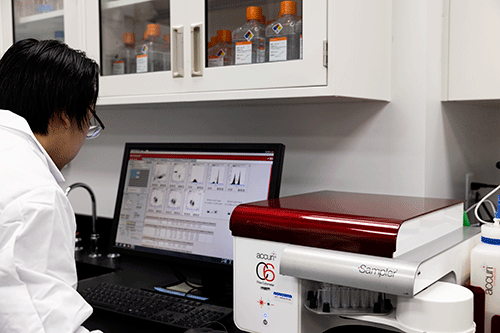FDA Draft Guidance on Chemical Analysis for Biocompatibility Assessment – Part 2
Key Takeaways
Within the last five years, there has been significant advancement in chemical analysis and toxicological risk assessment guidelines. Two significant ISO 10993 guidelines on these topics, Part 18 (in 2020) and Part 17 (in 2023) were revised and published. Last year FDA also issued a draft guidance on chemical analysis for biocompatibility assessment of medical devices. This draft guidance provides critical insights on the extractable testing recommendations for medical devices and some of the methodological expectations for chemical extractables studies included in premarket submissions. The guidance also aims to address potential gaps the FDA has identified as leading to inconsistencies across different labs and deficiencies in premarket submissions. In Part 1 of this 2-Part post, we focused on the recommendations for solvent selections and extraction conditions. In Part 2 of our continued discussion on the FDA draft guidance for the chemical analysis of biocompatibility, we will explore the recommended analytical methods and reference standards as additional elements crucial for ensuring the accuracy, reliability, and regulatory compliance of chemical analysis studies.

Analytical Methods
A significant portion of the guidance is focused on improving the quality and consistency of analytical methods. The recommended analytical techniques for volatile and semi-volatile organic compounds (VOCs and SVOCs) is Gas Chromatography-Mass Spectrometry (GC-MS). If a head-space GC-MS can be performed, it will supplement the data. For non-volatile and semi-volatile compounds Liquid Chromatography-Mass Spectrometry (LC-MS) is recommended. For elemental constituents (with polar solvents) an Inductively Coupled Plasma (ICP)-MS is recommended. Non-volatile residual (NVR) analysis should be analyzed through gravimetric analysis. Electrospray ionization (ESI) in both positive and negative modes is recommended for LC-MS analysis. Other primary detection methods include optical methods such as UV and diode array detectors (DAD).Fourier Transform Infrared Spectroscopy (FTIR) or total organic carbon analysis are typically supplemental information only.
For non-volatile residue, the current expectation is to perform replicate extractions (e.g., triplicate) for each solvent and with the entire volume dried for NVR analysis. If only an aliquot is used for NVR analysis, the aliquot volume and percentage of the whole extract must be reported, along with justification for the sensitivity of the approach in terms of mass/device. A comparison of the total NVR amount to the total mass from other chemical analyses (e.g., GC-MS for SVOCs, LC-MS for NVOCs, ICP-MS for elemental constituents) should indicate that no significant loss of extractables occurred during processing and analysis. All the chemical identities of extractables above the analytical evaluation threshold (AET) and the confidence of each identification should be reported. It is recommended to calculate the AET using the formula that is provided in ISO 10993-18. The dose-based threshold for the AET formula should be selected with an understanding of the device’s intended usage. The approach for calculating the Uncertainty Factors (UFs) for each analytical method should be described. A default UF value of 4 for GC-MS can be used without further explanation.
Reference Standards
A range of surrogate reference standards with diverse properties is recommended to avoid underestimating chemicals with low response factors. It is expected for GC-MS that at least three surrogates are needed, and for LC-MS, at least five. If the surrogates do not ionize in both positive and negative modes, additional standards should be included to adequately cover each polarity mode. Selected standards should represent varying properties such as volatility, molecular weight, polarity, and solubility, and should bracket the retention time range of analytes. The guidance also emphasizes the importance of ensuring the analytical methods have the appropriate sensitivity to detect trace amounts of potentially harmful chemicals. Calibration requires at least five non-zero concentration levels with reasonable linearity. If Limit of Quantifications (LOQs) are used for sensitivity, it must be lower than the reporting threshold (e.g., AET). It is generally not recommended to use Limit of Detections (LODs), as they are closer to background noise levels and less reliable for quantification. Adequate recovery in the levels of 80-120% are expected; otherwise, steps to improve recovery, such as multiple solvent exchanges or using solid phase extraction may be necessary. Solvent exchange should be performed three times at different pH levels (acidified, neutral, and basified aqueous phase).
Concluding Remarks
The FDA draft guidance on the chemical analysis methods for biocompatibility represents a significant step toward harmonizing analytical procedures and practices across different laboratories to expedite the review process. As the industry adapts to these evolving expectations, collaboration among manufacturers and analytical, toxicological and regulatory professionals, is a must. Additional guidance in the related areas of simulated use and reasonable recommendations to reduce animal testing in practice are still needed. It is essential to develop reliable new alternative approaches that complement traditional biocompatibility endpoints to ensure patient safety.
MED Capabilities
MED Institute specializes in providing comprehensive support for medical device chemical analysis and toxicological risk assessment. Our team of professionals offers expert guidance on selecting appropriate solvents, assessing gaps in protocols, resolving AET calculations, and interpreting analytical results in alignment with ISO 10993-18. Our experts are equipped to resolve challenges during the extractable testing or respond effectively to biocompatibility queries from regulatory agencies. We help clients with developing robust toxicological risk assessments, identifying toxicological hazards, assessing patient exposure, and developing margins of safety in alignment with ISO 10993-17. By engaging with our team of experts, several manufacturers have designed safer products, and accelerated their regulatory submissions and successful market entry.
Contact us today to discuss your project needs 855.463.1633 | askmed@medinstitute.com | medinstitute.com.
Get email about news, services, and events from MED Institute.
OUR COMMITMENT
We are committed to consistently performing services with high quality, that deliver exceptional results, and add value to the client’s business.
For client surveys sent in 2024, we received ratings of 4.98/5 points (13).

